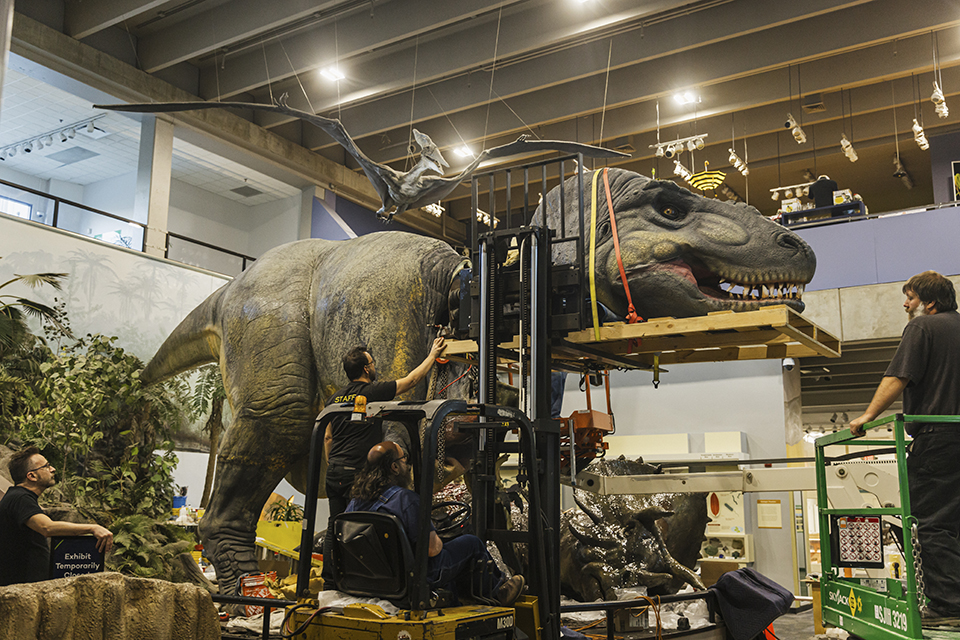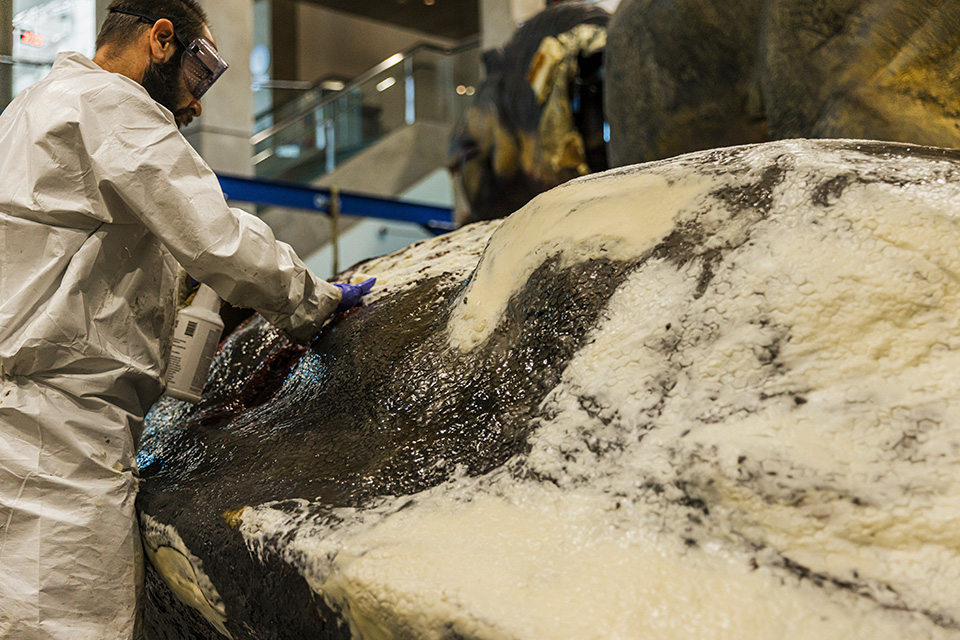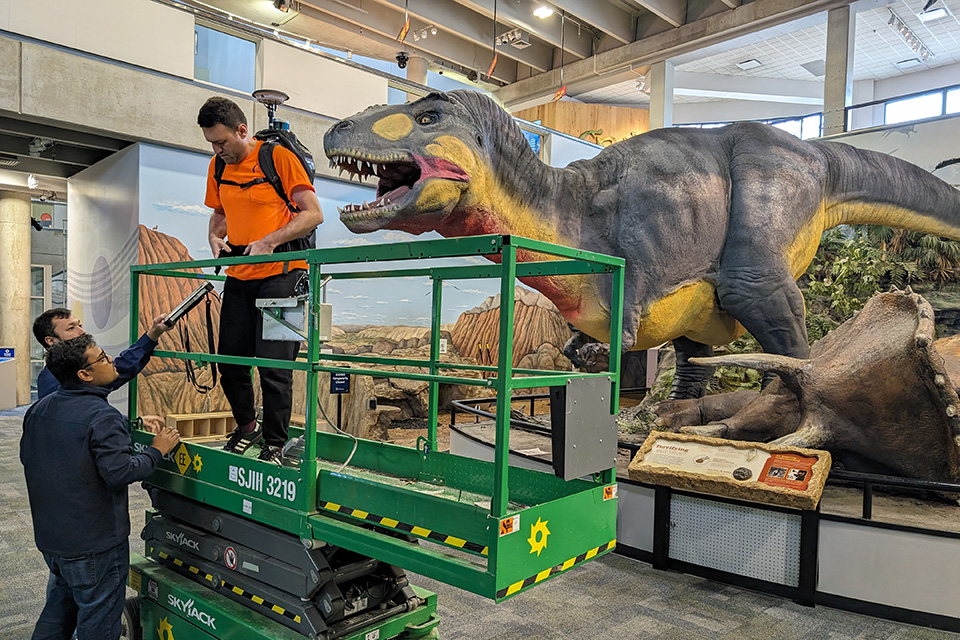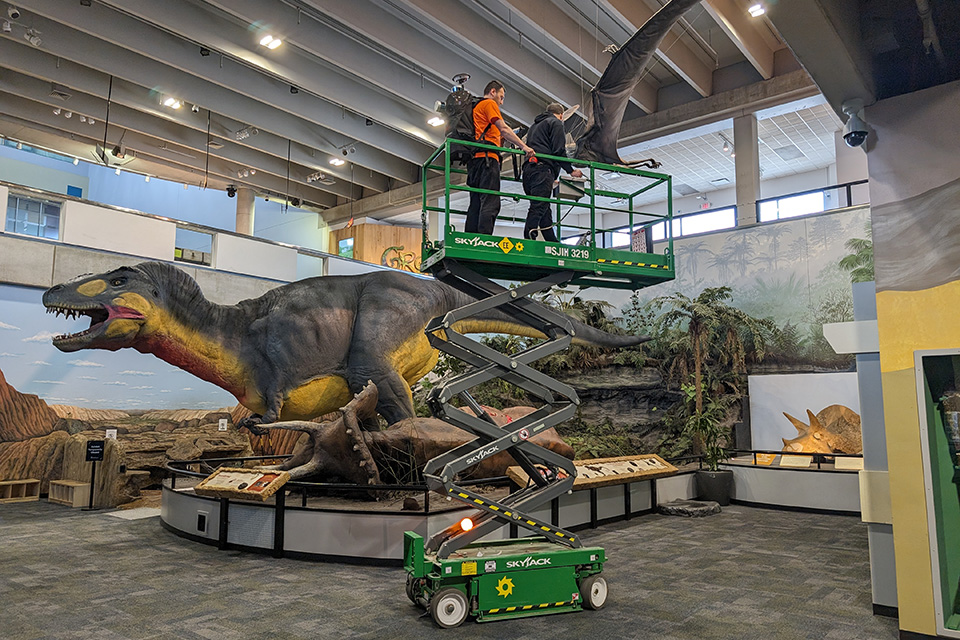Who Do You Call When Your 15-Foot Dinosaur Needs a Doctor?
Researchers at Saint Louis University and the Taylor Geospatial Institute are answering the call to ensure that future generations of visitors to the Saint Louis Science Center will be amazed by their robotic Tyrannosaurus rex.
If you’re more than 67 million years old — or in the case of the Saint Louis Science Center’s animatronic Tyrannosaurus rex, on daily display since the facility opened in 1991 — your parts may not move as swiftly as they had in the past, and you may need the occasional checkup. But, when the time comes for the science center to take steps to ensure the future of their guest favorite, a dilemma ensues: “Who can we call for help?” especially when the company that originally made the dinosaur went out of business long ago.
A Kink in the Neck
The summer of 2023 was like many summers before it at the science center. For months, throngs of guests filed through the building’s atrium, excited to be delivered from the jaws of vernal heat and humidity into an inviting space filled with wonder and discovery — and cool, conditioned air. As the crowds proceeded downstairs into the lower level, they were dwarfed — like countless visitors before them — by a 15-foot, rubber-skinned Tyrannosaurus rex that commands that space. The animatronic dinosaur would periodically swivel its massive head, bear its fearsome jaws, and bellow out a piercing roar. At its giant feet lay a vanquished Triceratops, side slashed open and bleeding.
But that June, the mighty head of the T. rex slumped forward, its animatronic machinery grinding to a halt and its internal steel skeleton hanging by a broken bolt just beneath its latex skin. The science center team quickly cordoned off the exhibit to keep guests from approaching the robotic reptile. Black plastic sheeting was draped over the head, which was eventually disarticulated and placed at the foot of the beast.
Chris Lucas, exhibit designer at the Saint Louis Science Center, and a crew of five or six team members who are responsible for the upkeep of exhibits were familiar with this particular problem. In 2006, the T. rex had malfunctioned in a similar way, its animatronic machinery breaking further back on the dinosaur’s neck. The science center team repaired the broken exhibit back then, patching together the internal metal armature, latex skin, and underlying foam to the best of their ability. To fix this more recent issue, the team worked with outside vendors throughout the summer and fall of 2023 to fabricate a new housing for the pneumatic parts that move the head, and they returned this fan favorite to the floor in time for the winter holidays.
Making the Old New Again

To prepare for future problems and to advance the model into a long-lived future,
Lucas had been talking for months with Andy Hall, D.Sc., director of Saint Louis University’s Center for Additive Manufacturing (SLU CAM). The science center was interested in tapping into SLU CAM’s 3D-printing capabilities
to create full-scale models of artifacts, such as fossils, that would give guests
a chance to physically interact with such objects while avoiding harm or damage to
the genuine articles.
“[The science center has] a lot of things that are behind glass, and things they don’t
even show because they’re that valuable,” Hall said. “We had had many on-and-off conversations
with them.”
This most recent T. rex breakdown provided a perfect opportunity for the science center
to see what SLU CAM could do for its exhibits on a dino-sized scale.
“Once I heard about the idea that [skin] molds could be created from a 3D scan,” Lucas said, “then I thought, ‘Maybe this is a good proof of concept for us working together.’”
Scanning for Collaboration
Lucas invited the SLU CAM team to come and test some of their 3D-scanning technology on exhibits at the science center, with a special focus on the broken-down T. rex. Hall and his colleague Michael Borovik, SLU CAM lead engineer, used one of SLU CAM’s handheld scanners to capture a detailed image of one of the dinosaur’s legs.
“In real time, it reconstructs the surface, including color, of whatever it is you’re scanning,” Hall said.
The pair also scanned a fossilized Triceratops skull that sits near the dinosaur diorama,
eventually 3D-printing a model of the fossilized relic.
Hall said that he and his SLU CAM colleagues quickly realized that their equipment
was not up to the task of scanning the entire surface of the animatronic T. rex. Handheld
scanners, he noted, are best at scanning things the size of a breadbox or perhaps
a little bigger. While it was technically possible to scan the whole T. rex, doing
so would be challenging, and extremely time-consuming.
Given these limitations, Hall’s thoughts went to the Taylor Geospatial Institute (TGI), which houses a data services team that is stocked with the latest sensors and geospatial
tools that are adapted to imaging large areas, such as agricultural fields or urban
landscapes.
“We took our hand scanner over there and scanned a leg,” Hall said. “After that, we
thought [the job] was better suited for the TGI technology.”

So Hall reached out to the TGI data services team, which includes Justin Vilbig, a geospatial data scientist. Hall knew that Vilbig might be able to apply advanced imaging technology, such as laser imaging, detection and ranging (LiDAR), to mapping the 3D surface of the T. rex’s latex skin. TGI could also map the diorama in which the dinosaur stands so that the whole display could potentially be replaced or repaired in the future. LiDAR works by bouncing light off a surface — usually the surface of the Earth — to determine its precise features and contours.
“Andy reached out to us saying that there seems like there’s a need for a pretty detailed 3D model of the T. rex,” Vilbig said. “The underlying purpose of this is to get centimeter-level accuracy on the whole diorama, because they will eventually need to replace all the skin pieces of the dinosaurs there. They want to have accurate measurements of them, so they don’t have to redo it every time they have to order a new part for it.”
Vilbig planned to approach the project from two angles, using backpack-mounted LiDAR scanners to image the T. rex from the ground and optical sensors affixed to a small drone that would fly around the exhibit and capture detailed 3D images. These two methods, working in tandem, would capture the surface of the dinosaurs in unprecedented detail.
“When you’re dealing with a target like this T. rex, if you’re off by 5 to 10 centimeters, you’re going to have an error, and if you’re trying to recreate measurements for this latex skin, you won’t have your seams match up,” Vilbig said. “The LiDAR scanner allows us to get really precise measurements.”
Vilbig and his team of geospatial data scientists typically use drone-mounted LiDAR above agricultural fields or archaeological sites to characterize plant growth or to search for subtle features on the ground. But they jumped at the chance to apply the technology in a unique setting.
“It’s not a huge lift for us, because it’s using the tech we use all the time. Just applying it in a unique environment,” Vilbig said. “For us, it was an opportunity to test the limits of the equipment we use all the time.”
Fix Now, Scan for Later
As the T. rex’s complex recovery continued, Lucas and the team at the science center made the decision to fix the dinosaur as they had in the past one last time. In mid-November, they installed new metal and pneumatic components that control the dino’s movements. And they used plenty of elbow grease to manually scrape away layers of paint and latex on the deteriorating skin so that they could apply fresh layers.
“We’re grinding away the old paint that’s on there,” he said, “so we can get the new skin to adhere to the old skin underneath.”

But as it grows ever older, the animatronic dinosaur is almost sure to suffer the effects of its advanced age again. So Lucas said that once the T. rex is back up and running, he’ll invite the SLU and TGI teams back to the science center to complete comprehensive scans of the beast. That way, the next time it breaks, science center team members can have a detailed replacement skin 3D-printed using the TGI team’s scans.
“In the future that skin is going to break down eventually,” Lucas said. “Once we
get the repair done, we want them to scan it, so that we know that’s where it’s at
in the future.”
Taking this proactive approach will free the science center from patching up the aging
reptile in the future and will relieve stress placed upon the T. rex from successive
attempts to patch up its skin.
“If we got a new fresh skin put on, we would probably lose hundreds of pounds of material,” Lucas explained.
That would hopefully also extend the lifespan of the internal components, which can
operate more freely if the additional weight of repairs past is not stressing the
entire structure.

Vilbig said the collaboration with the science center allows him and the TGI data services team to test and develop their equipment and scientific processes in a nontraditional environment and with a unique target. Vilbig and his TGI colleagues will return there to scan the T. rex and its surrounding exhibit mates in the nearby diorama to ensure a pathway to a quick fix in the event of future problems with the iconic exhibit.
“It’s cool data for us to be able to test some of the new algorithms and new modeling
approaches for photogrammetry where we try to see how this unique object can be reconstructed,”
he said. This new forum for geospatial science and technology could instruct future
projects at the science center or other spaces outside of the agricultural fields
and archaeological sites on which the TGI team frequently works.
Lucas agreed that a collaboration with SLU and TGI could bear fruit beyond a new,
3D-printed dinosaur skin.
“We look forward to continuing this relationship for sure,” he said.
Vilbig added that he’s thrilled to work at a venerated St. Louis institution such as the science center.
“I went to the science center as a kid and remember both loving and being really scared of that exhibit. So as an adult, it’s really rewarding to be able to go back there and be able to help the science center continue that diorama legacy,” Vilbig said. “Because hopefully kids today will go and have that same reaction. That’s a fun continuity thing for me to feel that connection and to help the science center, which is such a cool institution.”
Story by Bob Grant, executive director of communications, research.
This piece was written for the 2023 SLU Research Institute Annual Impact Report. The Impact Report is printed each spring to share the successes of our researchers from the previous year and share the story of SLU's rise as a preeminent Jesuit research university. More information can be found here.

















